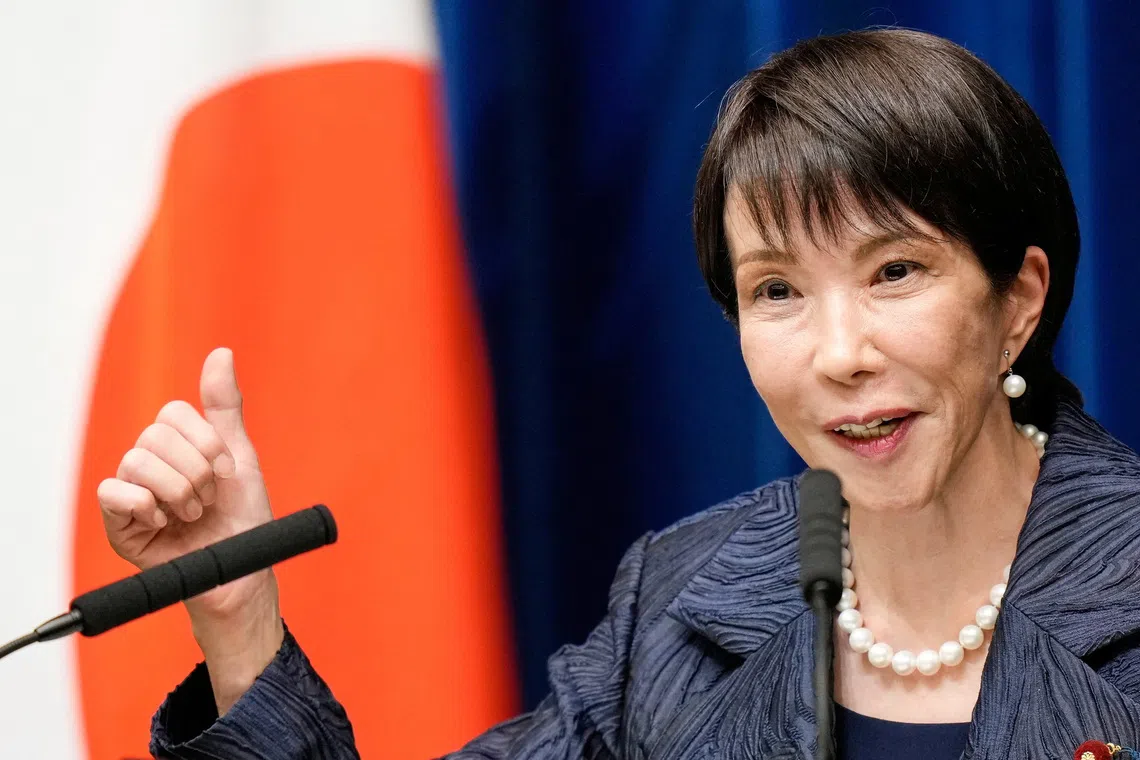Japan’s new PM is preparing large economic stimulus to tackle inflation: Sources
Sign up now: Get ST's newsletters delivered to your inbox

Japanese Prime Minister Sanae Takaichi's first major economic initiative will be built around three main pillars.
PHOTO: REUTERS
Follow topic:
TOKYO - Japan’s new Prime Minister Sanae Takaichi is preparing an economic stimulus package that is likely to exceed 2024’s US$92 billion (S$119 billion) to help households tackle inflation, government sources familiar with the plan said on Oct 22.
The package of more than 13.9 trillion yen (S$119 billion) is Ms Takaichi’s first major economic initiative since the advocate of big fiscal spending took office on Oct 21
It will be built around three main pillars: measures to counter inflation, investment in growth industries and national security, the sources said, declining to be identified because the matter is still private.
Japan’s benchmark Nikkei erased losses and turned higher on Oct 22 after the Reuters report, while the yen pared morning gains and was little changed.
Investors are closely watching Ms Takaichi’s spending plans as Japan is one of the world’s most indebted economies.
As part of its core inflation relief measures, the Takaichi administration plans to swiftly abolish the provisional gasoline tax rate.
It also aims to expand local government grants, with a focus on supporting small and medium-sized companies that are unable to benefit from existing tax incentives for wage hikes.
The package will also include investments in growth sectors such as artificial intelligence and semiconductors as the government focuses on strategic economic development.
The exact scale of the package is still being finalised, the sources said. It could be announced as early as next month.
It was too early to talk about the size of the upcoming extra budget, Japan’s new finance minister, Ms Satsuki Katayama, said at a news conference on Oct 22, but it should be of sufficient scale to cover all measures needed.
To fund the measures, the government is moving ahead with drafting a supplementary budget for the current financial year through March, with an eye toward passing it during the upcoming extraordinary Parliament session.
If additional spending exceeds initial expectations, the government may need to issue deficit-covering bonds, raising questions about how to balance economic growth with fiscal discipline.
The plan “is consistent with Takaichi’s policy list during the campaign (in the ruling party’s leadership race)”, said Mr Shigeto Nagai, head of Japan economics at Oxford Economics.
It is not so different from previous administrations, which have used all the additional tax revenue from higher inflation for large supplementary budgets to support vulnerable households, rather than working towards its goal of achieving a primary fiscal surplus, Mr Nagai added.
Ms Takaichi was elected Japan’s first female prime minister on Oct 21.
The Parliament vote drove down the yen and bond yields on expectations that Ms Takaichi’s presence could delay further interest rate hikes by the Bank of Japan (BOJ).
A long-time advocate of late prime minister Shinzo Abe’s “Abenomics” stimulus policies, Ms Takaichi has called for higher spending and tax cuts and pledged to reassert government sway over the central bank, which is weighing more interest rate hikes and will hold its next policy meeting on Oct 29 and 30.
Monetary policy is part of a broader economic policy the government holds final responsibility for, she told a news conference on Oct 21, adding that specific means of monetary policy were up to the BOJ to decide. REUTERS

